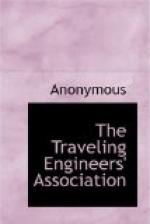A. Air enters the control valve at the connection marked “BP” (Fig. 21), which leads to chamber “F” above the piston 3, forcing it down, uncovering the feed groove “G” in the bushing, allowing air to feed past the piston into the slide valve chamber, and then through port “H” to the auxiliary reservoir. The air will feed through in this manner until the auxiliary reservoir and brake pipe pressure equalize. When a gradual reduction of brake pipe pressure is made, it will be felt in chamber “F”, above piston 3, creating a difference in pressure on the two sides of the piston, which will cause it to move upward.
[Illustration: Fig. 21. Automatic Control Valve. Full Release.]
The first movement of the piston closes the feed groove “G”, also moves the graduating valve 10, uncovering the service port “J” in the slide valve 4, and the continued movement of the piston moves the slide valve to service position, in which the service port “J” connects with port “E” in the valve seat. (See Fig. 22.) As the slide valve chamber and auxiliary reservoir are connected at all times, air can now flow from the auxiliary to the control cylinder “D” and control reservoir, through ports “H”, “J” and “E”, until the pressure on the lower or auxiliary side of piston 3 becomes slightly less than that in chamber “F” or brake pipe side, when the piston and graduating valve will move down until the shoulder on the piston strikes the slide valve; this movement of the graduating valve closes the service port “J”, thus closing the communication between the auxiliary and control cylinder and reservoir, also closing port “W”, which leads to the safety valve. (See Fig. 23.)
175. Q. How is piston 2 affected by the air pressure in the control cylinder “D”?
A. Pressure forming in this cylinder will force the piston downward. The piston in moving down will carry the exhaust valve 7 with it, closing the exhaust port “N” and moves the preliminary admission valve “1A” from its seat against the tension of spring 8, allowing the pressure in chamber “O” to pass to the brake cylinders, thus creating a balancing effect on valve 1, which allows it to be opened against main reservoir pressure, thus allowing main reservoir air to flow from chamber “A” to chamber “B” and the brake cylinders on the locomotive (see Fig. 22) until the pressure in the brake cylinders and chamber “B”, below piston 2, becomes slightly greater than that in the control cylinder “D” when the piston will move up just far enough to allow the valves “1” and “1A” to be seated, or to lap position. (See Fig. 23.)
[Illustration: Automatic Control Valve. Service Position. Fig. 22.]
176. Q. With the control valve now in lap position, will the brake release on account of brake cylinder leakage?




